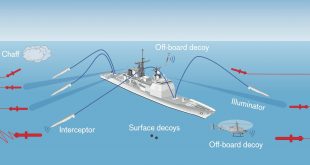There are many definitions of technological innovation: “technological innovation is a process which includes the technical, design, manufacturing, management and commercial activities involved in the marketing of a new (or improved) product or the first use of a new (or improved) manufacturing process or equipment” A national system of innovation, “is that …
Read More »Rising employment of AI in Air & Missile Defense as threats become Hypersonic
Militaries around the world are increasingly facing a formidable strategic threat environment in terms of complexity, lethality, range, sophistication, and number of threats. These range from Fifth-generation stealth fighters, unmanned air vehicles, and more maneuverable and precision-guided ballistic, cruise, and Hypersonic missiles that are becoming widely proliferated to become more …
Read More »Through the wall imaging (TTWS) or Wall-penetrating radar technologies assist security forces in counterterrorism and diaster management operations
Urban Warfare Operations are complicated by a three-dimensional environment, limited fields of view because of buildings, enhanced concealment and cover for defenders, and the ease of placement of booby traps and snipers. Unknown individuals hidden from view can slow emergency efforts and can increase the inherent dangers of tactical operations. …
Read More »DARPA Airborne Energy Well seeks laser propulsion on Aircrafts to power Rechargable Unmanned Aerial Systems
A laser is a device that emits a beam of coherent light through an optical amplification process. Laser propulsion is any method of propelling a spacecraft that uses the energy of laser beams. There are two main types of laser propulsion, depending on whether the laser is onboard or …
Read More »Spacecraft Interface Control Document (ICD)
The definition, management, and control of interfaces are crucial to successful programs or projects. Interface management is a process to assist in controlling product development when efforts are divided among parties (e.g., Government, contractors, geographically diverse technical teams, etc.) and/or to define and maintain compliance among the products that should …
Read More »Spacecraft Mechanical Sub-system Design & Manufacturing
Mechanical engineering is an engineering branch that combines engineering physics and mathematics principles with materials science, to design, analyze, manufacture, and maintain mechanical systems It is one of the oldest and broadest of the engineering branches. “Mechanical Engineering takes in all built structures and moving parts flown in space, …
Read More »Satellite Electrical Ground Support Equipment (EGSE)
There is growing utilization of miniaturized satellites for military and defense applications. Defense organizations have been launching communication nanosatellites and microsatellites to provide communication signals to soldiers stationed in remote locations or in dense forests. The military needs more data bandwidth and reliable communications infrastructure for its UAVs, which can …
Read More »Raytheon’s AN/SPY-6(V) is and integrated air and missile defense naval radar that can track multiple ballistic and cruise missile targets.
Navies around the world are increasingly facing formidable strategic and threat environments in terms of complexity, lethality, range, sophistication and number of threats. Many of these threats, including long-range anti-ship cruise missiles, can travel hundreds of miles to their targets, toward surface ships challenged to detect the approaching weapon with …
Read More »Satellite Harness Design, Optimization and Standards
Wire harnesses are bundled assemblies of cables and connectors, that are used to transmit signals and power between components. If we could compare a satellite to the human body, the electrical harness would represent the blood vessels conveying the power and the nervous network transmitting the commands and sensor information …
Read More »Matlab and Simulink
Modeling is the process of representing a model (e.g., physical, mathematical, or logical representation of a system, entity, phenomenon, or process) which includes its construction and working. This model is similar to a real system, which helps the analyst predict the effect of changes to the system. Simulation of a …
Read More » International Defense Security & Technology Your trusted Source for News, Research and Analysis
International Defense Security & Technology Your trusted Source for News, Research and Analysis


